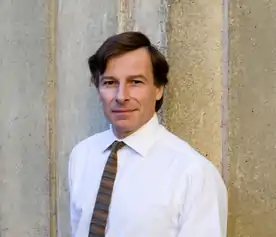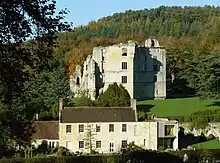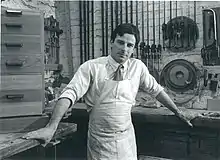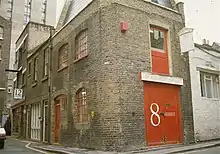Luke Hughes (furniture designer)
Luke Hughes is an English furniture designer and former maker, founder and CEO of Luke Hughes and Company Limited,[1][2] whose designs can be found in many of Britain’s institutional buildings including Westminster Abbey,[3] the two chapels in the Tower of London,[4] the Supreme Court of the United Kingdom,[5] 24 cathedrals, more than 100 parish churches, 60 of the 70 Oxford and Cambridge University Colleges, and a number of official professional headquarters such as the Royal Institute of British Architects and the General Medical Council. His work also extends to 900 corporate boardrooms, academies in China,[6] universities[7][8] and synagogues[9][10][11] in the United States. He is an accomplished mountaineer and has explored unmapped areas of central Tibet. He is married to Polly Phipps (daughter of Jack Phipps) who is joint CEO of his eponymous company. They have one daughter.

Early life
Hughes was born in London on 11 May 1957. His father Jan Nasmyth[12] and mother Jenny Turner,[13] married in 1949, came from the British professional and civil servant classes; his maternal great-grandfather Claud Schuster[14] (later Lord Schuster of Cerne Abbas) was Permanent Secretary to the Lord Chancellor’s Office from 1915-1945. His paternal grandmother, Dorothea Maude[15] was a pioneering woman doctor who, in World War I, had defied the War Office to work in military hospitals across Belgium, Serbia and Greece. Maude claimed descent from two of Charles II’s mistresses, Nell Gwyn and Louise de Kérouaille.
Nasmyth, an economist and independent minded journalist who, after being wounded and evacuated at Dunkirk is credited with a role in the development of the British Army’s Small Scale Raiding Force, forerunner of the Special Boat Squadron,[16] writing a paper on the philosophy of small-scale raiding parties which was later adopted by Special Operations Executive (SOE) as the blueprint for such activities. Nasmyth went on to found the newsletter, Europ-Oil Prices and later Argus Media.[17]

Jenny Turner was an influential and pioneering intellectual, one of the first women to be appointed to the diplomatic corps and later a journalist for The Economist and The Manchester Guardian and presenter for television current affairs programmes. She became personnel director of Macmillan Publishers in 1974.[18]
Luke Hughes has a brother, Kim Nasmyth the molecular biologist and geneticist, and two sisters, Jessica, a former music agent, and Polly his half-sister, a distinguished violinist who died of a brain tumour in 1997.
Jan and Jenny’s marriage was annulled in 1960, and in 1961 she married Billy Hughes,[19] a circuit judge and bibliophile with whom she set up home under the walls of Wardour Castle[20] in Wiltshire, in the dilapidated Wardour House which the couple restored to great effect. (Luke Hughes changed his surname to Hughes when he was 18.)

Hughes’s fascination with architecture and the building trades – especially carpentry - came from this part of his childhood, but he attributes his commitment to craftmanship to his time sweeping up in the workshop of renowned harpsichord maker Michael Johnson[21] who shared space with José Romanillos,[22] guitar maker to musician Julian Bream.
Hughes’ love of climbing, which he would practise on the walls of the castle itself, also comes from this time. There is a strong mountaineering tradition in his family background, five of his forebears being committed climbers in the 1860s and 70s, and Claud Schuster becoming President of the Alpine Club[23] (to which Hughes belongs) in the 1930s.
Hughes was educated at Salisbury Cathedral Choir School and St Paul’s School in London, and after a gap year spent as a midshipman and carpenter’s mate on the Blue Funnel cargo-liner MV Atreus in the South China Seas, in 1975 went up to Peterhouse[24] in the University of Cambridge on an open history scholarship. He changed course from Mediaeval History to History of Architecture and dabbled with Oriental Studies. On coming down from Cambridge he took a two-year law conversion course at Bristol Polytechnic, supporting himself by restoring Morris Minor Travellers, the wood-framed estate version of Britain’s most popular post-war small family saloon.
Design and Craftsmanship

Hughes was temporarily working as a carpenter on London building sites in 1979 when a chance encounter with Lt Col David Gordon-Lennox, the commanding officer of the Grenadier Guards, led to a commission for kitchen shelving. From there came the task of refurbishment of the Guards’ archive library, the first library project in a long line which led through a series of bookcases for Inns of Court lawyers[25] to the Supreme Court of the United Kingdom in 2009.[26] It allowed Hughes to set up Bloomsbury Joinery in 1980 in the back yard of a small house in Lamb’s Conduit Street, Covent Garden, which he had bought with his brother and a friend. In 1981 the opportunity arose to purchase a small vegetable warehouse nearby in Stukeley Street, a throwback to the days when Covent Garden was London’s central distribution point for fruit and vegetables. The building was acquired at a much depressed price because it was the subject of a compulsory purchase order from the Greater London Council, which planned to redevelop the area. The Council was abolished in 1986[27] before the plans could be realized and Hughes found himself the freeholder of a premium property at a knockdown price in one of the most sought-after and exclusive districts of Central London. Luke Hughes and Company Limited was incorporated in the same year.

In the late 1980s the workshop’s output was mostly for residential clients. The same period also saw Hughes’ short-lived and ultimately ill-fated engagement with design for the retail market in the form of the robust but modestly priced ‘Ovolo’ range of bedroom furniture, originally manufactured by struggling Birmingham reproduction furniture company Juckes and sold through upmarket outlets such as Heal’s, Liberty’s and John Lewis. Venture capital was raised and significant investment made in a factory in Wiltshire which opened in 1990. Copyright infringement and the deep UK recession of the late 1980s, which forced the factory’s eventual closure in 1994, prompted a decision to target recession-proof clients with long-term needs to furnish their buildings of architectural quality – namely the colleges of Oxford and Cambridge Universities. Much was owed in this strategic shift to Ray Leigh,[28] appointed chairman of the limited company in 1990, and an architect who had become first the design director then managing director of iconic Cotswold furniture manufacturer Gordon Russell.[29] Here is the substantive link to the Arts and Crafts movement[30] which is so important in Hughes’ philosophy of design and manufacture.
In 1990 Hughes opened a showroom / studio in Drury Lane, Covent Garden. The first Oxbridge commission, of dining hall furniture for Corpus Christi College Cambridge, came in 1991, a job which also marked the company’s first use of computer-aided design.[31] The first commission for the Foreign Office – the British Embassy in Buenos Aires – and the first order over £250,000, for Merton College Oxford, followed in 1992. 1997 saw a high-profile commission for the idiosyncratic new British Embassy in Moscow, designed by Ahrends Burton Koralek,[32][33] and in 1998 came the first order of over £500,000, for St Hugh’s College Oxford. The late 1990s also saw the development of meeting and conference room tables for the executive boardroom market, culminating in two widely publicised corporate HQs for Unilever and Diageo.[34]
By this time Hughes was writing and lecturing regularly for institutions such as the Royal Society of Arts[35] and magazines such as Crafts and Woodworker. He sets himself apart from the contemporary generation of middle-class British furniture designers and makers by his entrepreneurship, but remains deeply committed to the Arts and Crafts movement design principles of the dignity of manual labour and honesty to materials and process. His lecture ‘Spokeshaves, Spanners, and Computers’, originally delivered to the Royal Society of Arts and published in Crafts magazine in 1999, was subsequently published in The Independent newspaper[36] and has been re-published twice in Crafts.[37] It sets out his vision for a vital craft-based industrial sector: ‘Modern artisans, building or craft, are as good as they have ever been. Only now they are better educated, work harder and are more financially acute than ever before. They have in their own workshops sophisticated industrial processes on a smaller, more economic scale than ever before. They understand the implications of technology and how to apply it and as a group of entrepreneurs, they have become an economic force of their own.’
The other element of Hughes’ design philosophy is his conviction that great architecture needs great furniture. Response to the architecture is key; an understanding of architecture and the design process, and sympathy for the architect who designed it, are central to the work. The pivotal idea infusing Hughes’s approach is that ‘in any quality building, the connection between architecture and furniture should be seamless, creating a sense of “rightness”, both functionally and aesthetically. Most buildings cannot function without the furniture, yet inappropriate furniture can grossly undermine great architecture.[38][39]
Significant projects
- Westminster Abbey – sanctuary furniture (used during the visit of Pope Benedict in September 2010 and the Royal Wedding in April 2011),[40][41] Westminster Abbey.[42]
- Sainsbury Botanic Institute, University of Cambridge (winner of the RIBA Stirling Prize 2012).[43]
- Library and court room furniture for the Supreme Court of the United Kingdom, Westminster.[44][45]
- Scottish Supreme Court Library, Edinburgh
- British Embassy, Moscow[46]
- Theatre Royal, Bury St Edmunds[47]
- Cathedrals – including St Albans, St Giles' Edinburgh,[48] St Paul's, Bristol, Exeter, Hereford, Rochester, Winchester, Ely,[49] Westminster Abbey,[50] Westminster Cathedral.
- Libraries – including, in Cambridge, the University Library and the Institute of Criminology, as well as Peterhouse, Pembroke and Selwyn; in Oxford, St Hugh's and Brasenose colleges. At Yale, this includes the Manuscripts and Archives Room at the Sterling Memorial Library and the Beinecke Library.[51]
- Hotels - including Mandarin Oriental (London, Las Vegas), Peninsula Hotels (Hong Kong, Tokyo, Bangkok) and Ritz Carlton (Los Angeles, Bahrain, Moscow).
- Schools - including Eton, Benenden, Bryanston, Charterhouse, Epsom, Harrow, Highgate, Oundle, Winchester, St Paul’s School and St Paul’s Girls School.
- Corporate boardrooms including Unilever, Diageo,[52] P&O, Bloomberg, Reuters and more than two hundred meeting rooms around the world for Royal Bank of Scotland. The Edward P. Evans Hall, Yale University School of Management.[53]
- Synagogues: Congregation Beit Simchat Torah[54] and The Park Avenue Synagogue.[55]
- Lecture theatres[56] for Keystone Academy, Beijing.
Clubs and Committees
- 1993–1998 Member of the Crafts Council of Great Britain
- 1994–1997 Chairman of Crafts Council Grants Committee
- 1996–1998 Academic Review Board, Prince of Wales Institute of Architecture
- 2001–2007 Chairman of Trustees, Art Workers' Guild
- 2005–2008 Honorary Designer, the Worshipful Company of Furniture Makers
- 2006 Liveryman of the Worshipful Company of Carpenters
- 2006–present Fabric Advisory Committee for Southwark Cathedral
- 2007–2010 Judge, Wood Awards
- 2011–2016 Management Committee, Mount Everest Foundation
- 2015–present Trustee, Sylva Foundation, environmental charity working to revive Britain’s wood culture
- 2016–2018 Chairman, Mount Everest Foundation
- 2018–2020 Trustee, Building Crafts College
- Founder member of the Woodland Heritage Trust.
- Fellow of the Royal Society for the encouragement of Arts, Manufactures & Commerce and the Royal Geographical Society.
- Member of the Alpine Club, Garrick Club, and Art Workers' Guild.
Articles
Pieces for, among others: The Economist, London Review of Books, Royal Society of Arts Journal, The Ecclesiologist, Architects’ Journal, Crafts Magazine, Spectator, The Independent, Alpine Journal, Himalayan Journal; also substantial contributions to Encyclopaedia of Wood (Quarto 1988)
Lectures
For, among others: the Royal Institute of British Architects, Royal College of Art, Royal Society of Arts, Institute of Wood Science, Crafts Council, Art Workers' Guild, Geffrye Museum, Cambridge Architecture Faculty, Christie’s, Alpine Club, Royal Scottish Geographical Society, Save the Children Fund and, specifically, on Sustainability and Design at international conferences in Amsterdam, Abu Dhabi, Auckland, Beijing, Shenzhen, Brisbane, Bangalore, Bombay, Brisbane, Dubai, Hong Kong, Melbourne, Singapore, Sydney etc.
Mountaineering
Expeditions include North face of The Eiger and to within 100m of the summit of Everest via the Hornbein Couloir: also pioneering expeditions to Tibet (six trips), Nepal (eight trips), Kashmir (two trips), Greenland, Rockies, Alps, and Pyrenees. Hughes spent his 60th birthday at 6,500m on the border of Tibet and West Nepal.[57]
 Luke Hughes on North Face of The Eiger - 1986 |
 Luke Hughes on Mt Xixabangma - 1987 |
 Luke Hughes on Mt Xixabangma, 8027m. Mt Pungpa Ri in the background - 1987 |
Other
In 1988, Hughes was one of the main characters portrayed in (and involved in the filming of) ‘On The Big Hill’,[58] Granada TV’s six-part documentary about Mt Everest.
Other character sketches appear in:
- ‘On The Big Hill – A Non-Climber’s Everest’ by Mark Anderson, Faber 1988;
- ‘Through Wood And Dale – Diaries 1975-1978’ by James Lees-Milne, John Murray 1998;
- ‘Two Degrees West’ by Nicholas Crane, Viking 1999;
- ‘Military Mountaineering’ by Bronco Lane, Hayloft 2000;
- ‘Higher Than The Eagle Soars – A Path to Everest’ by Stephen Venables, Hutchinson 2007;
- ‘Summit – 150 years of the Alpine Club’ by George Band, Collins 2006;
- ‘Six Celebrations On Reaching Seventy’ by Brian Masters [q.v], privately published 2013.
In 2016, Hughes was interviewed for ‘Crafts Lives’[59] by the British Library’s Oral History Collection:
Further reading
- ‘Furniture in Architecture: The Work of Luke Hughes’ by Aidan Walker, Thames & Hudson 2020
- ‘The Arts and Crafts Movement’, by Rosalind P Blakesely, Phaidon Press 2006
- ‘The Crafts in Britain in the Twentieth Century’, by Tanya Harrod, Yale University Press 1999
- ‘William Morris: A Life for Our Time’ by Fiona MacCarthy, Faber & Faber 2010
- ‘Anarchy & Beauty: William Morris and His Legacy, 1860 – 1960’ by Fiona MacCarthy, National Portrait Gallery 2014
- ‘London: Hidden Interiors’ by Philip Davies, English Heritage and Atlantic Publishing 2012
- ‘Pews, Benches and chairs’ edited by Trevor Cooper and Sarah Brown, Ecclesiological Society 2011
- ‘Keeping Somerset Churches Alive’[60] by Hugh Playfair, Spring 2010,
- ‘The Supreme Court of the United Kingdom’ edited by Chris Miele, Merrell 2010
- ‘Art Workers Guild: 125 years – Craftspeople at work today’ by Lara Platman, Unicorn Press 2009
- ‘Keble College, past and present’ by Averil Cameron, Merrell 2009
- ‘Classic chairs’ (introduction by Alan Powers), Luke Hughes and Company 2006
- ‘Country Houses Today’ by Jeremy Melvin, John Wiley & Sons 2006
- ‘British Embassy in Moscow’ by Jeremy Melvin, Foreign & Commonwealth Office 1999
- ‘Building for the future’ by Clare Stevens, St Barnabas, Dulwich 1997
- ‘The Technique of Furniture Making’ by Ernest Joyce, Batsford 1987
Sources
- "Luke Hughes & Company website". lukehughes.co.uk. Retrieved 21 June 2020.
- "Company website's 'About' page". lukehughes.co.uk. Retrieved 21 June 2020.
- "Seats at the wedding". Old Pauline news. 2011.
- "Chapel Royal of St Peter ad Vincula case study". lukehughes.co.uk. Retrieved 21 June 2020.
- "UK Supreme Court - design of the court furniture & library, case study". lukehughes.co.uk. Retrieved 21 June 2020.
- "Keystone Academy Library Beijing, case study". lukehughes.co.uk. Retrieved 21 June 2020.
- Woodman, Ellis (February 2015). "Edward P Evans Hall at Yale University by Foster + Partners". The Architects' Journal.
- de Monchaux, Thomas (7 July 2014). "Edward P. Evans Hall, Designed by Foster + Partners". Architect Magazine.
- Davidson, Justin (1 April 2016). "Gay Synagogue Moves From the West Village, But Takes Its Rich Civil-Rights History With It". New York Magazine.
- "Congregation Beit Simchat Torah by Architecture Research Office". Architectural Record. 1 May 2016.
- Prince, Cathryn J. (20 October 2016). "After 40+ years in 'desert,' New York's biggest LGBTQ synagogue has a fancy new home". Times of Israel.
- "Jan Nasmyth: nonconformist oil industry journalist". The Times. 26 September 2008.
- "Jenny Hughes, pioneering broadcaster and diplomat – obituary". The Daily Telegraph. 31 January 2020.
- The Times, 29 June 1956;
- Fedunkiw, Marianne P. (May 2010). Maude, Dorothea Clara (1879 – 1959), Oxford Dictionary of National Biography. Oxford University Press.
- "Jan Nasmyth: nonconformist oil industry journalist". The Times. 26 September 2008.
- Ghaddar, Ahmad (23 May 2016). "General Atlantic to buy majority stake in Argus Media". Reuters.
- "Jenny Hughes, pioneering broadcaster and diplomat – obituary". The Daily Telegraph. 31 January 2020.
- "Jenny Hughes, pioneering broadcaster and diplomat – obituary". The Daily Telegraph. 31 January 2020.
- "Old Wardour Castle website". english-heritage.org.uk. Retrieved 21 June 2020.
- "8th e-newsletter of the British Harpsichord Society" (PDF). harpsichord.org.uk. Retrieved 21 June 2020.
- "José Luis Romanillos". guitarsalon.com. Retrieved 21 June 2020.
- "Alpine Club website". alpine-club.org.uk. Retrieved 21 June 2020.
- "Peterhouse Cambridge website". pet.cam.ac.uk. Retrieved 21 June 2020.
- Steiner, Rupert (29 June 1997). "Carpenter carved out success by going against the grain". The Sunday Times.
- A visit to the Supreme Court Library. Inner Temple Newsletter. 2011.
- Hansard (1803–2005). Streamlining the Cities (Report). Parliament of the United Kingdom.
- "22nd e-newsletter of the Gordon Russell Design Museum" (PDF). www.gordonrusselldesignmuseum.org.uk. Retrieved 22 June 2020.
- Myerson, Jeremy (1992). Gordon Russell, Designer of Furniture. The Design Council of Great Britain.
- Blakesley, Rosalind P. (2006). The Arts & Crafts Movement. Phaidon.
- Timeline: The Story So Far. Luke Hughes and Company. 2012.
- Melvin, Jeremy (1999). British Embassy in Moscow. Foreign & Commonwealth Office.
- Powell, Kenneth (2000). From Russia with love - the Moscow embassy. Royal Academy Journal.
- "The spirit of enlightenment – Diageo headquarters". Architecture Today (AT 135 ed.). February 2003.
- "RSA website". thersa.org. Retrieved 22 June 2020.
- Hughes, Luke (22 November 1999). "Podium: Spokeshaves, spanners and computers". Independent.
- Hughes, Luke (December 2017). "Craft's place in post-Brexit Britain". Crafts magazine. p. 26.
- "Company website's 'Furniture in Architecture' projects page". lukehughes.co.uk. Retrieved 17 April 2020.
- Lim, Candice (2012). "In conversation with Luke Hughes". Futurarc: the Voice of Green Architecture in Asia (vol 27 ed.).
- Haselock, Jeremy (2012). "The Cosmati Pavement". Art & Christianity spring 2012.
- "New Octagon Furnishings". The Octagon. 2018.
- "Seats at the wedding". Old Pauline news. 2011. p. 87.
- Mara, Feliz (11 October 2012). "Sainsbury Laboratory, University of Cambridge, Stanton Williams". The Architects' Journal.
- Miele, Chris (2010). The Supreme Court of the United Kingdom. Merrell.
- Engel, Matthew (20 April 2013). "British Institutions: The Supreme Court". Financial Times.
- Melvin, Jeremy (1999). British Embassy in Moscow. Foreign & Commonwealth Office.
- Adshead, David (14 February 2008). "King of Theatres". Country Life.
- Newbury, Helen (April 2011). New Holy Table for St Giles Cathedral, Edinburgh. Church Building.
- "New Octagon Furnishings". The Octagon. 2018.
- "Seats at the wedding". Old Pauline news. 2011. p. 87.
- Walker, Aidan (2020). Furniture in Architecture: The Work of Luke Hughes. Thames & Hudson. p. 192.
- "The spirit of enlightenment – Diageo headquarters". Architecture Today (AT 135 ed.). February 2003.
- Woodman, Ellis (February 2015). "Edward P Evans Hall at Yale University by Foster + Partners". The Architects' Journal.
- Davidson, Justin (1 April 2016). "Gay Synagogue Moves From the West Village, But Takes Its Rich Civil-Rights History With It". New York Magazine.
- "Park Ave. Synagogue Celebrates A $96 Million Expansion". timesofisrael.com. Retrieved 17 April 2020.
- "Lecture theatre design - Keystone Academy, case study". lukehughes.co.uk. Retrieved 22 June 2020.
- ‘Karnali Country’ by Julian Freeman-Attwood, Alpine Journal 2019.
- "BFI website". bfi.org.uk. Retrieved 23 June 2020.
- "British Library website". bl.uk. Retrieved 23 June 2020.
- "Keeping Somerset churches alive" (PDF). somersetchurchestrust.org. Retrieved 17 April 2020.